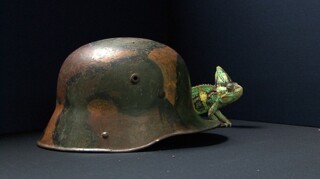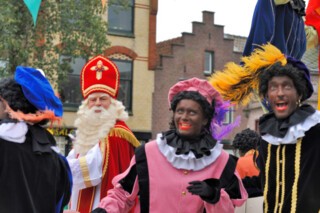Subliminal Falsehood
Glen Newey
Foam, Amsterdam’s photography museum, has been running a show on Disguise and Deception featuring work by Anika Schwarzelose, derived from the Tarnen und Täuschen camouflage unit of the German army. On Monday, Foam staged an associated symposium at the Marineterrein naval base. A video by Roy Villevoye featured a German coal-scuttle Second World War helmet. A green blob emerged from behind the helmet. It looked like a leaf. A dark speck moved across it – a fly, I thought.The helmet remained impassive. The leaf turned out to be a chameleon’s head, and the speck its lazily flickering eye. Villevoye explained that the chameleon, Jack, had been cross on the day of filming. They knew he was cross because he’d turned aubergine; he only calmed down after congress with a female chameleon. In the film Jack, maybe still pissed off, makes no obvious effort to blend into the background.
Human chameleonism takes many forms. Disguise sometimes doesn’t aim directly to deceive, but to mask an ulterior deceptive project. At Foam, the historian Seán O’Sullivan discussed Britain’s ‘Ghost Army’ unit in the Second World War, which put out bogus morse and radio signals to make the Germans expect an allied invasion of the Pas de Calais. It also created inflatable dummy tanks. Some were draped with token foliage – a twig or ravaged bough – intended to look real enough to make German aerial reconnaissance take it as an attempt at camouflage, but still show the fake tank.
In the old American South, white minstrels blacked up with burnt cork to play ‘Negro’ tunes for white audiences (a quaint tradition that survived on the BBC till the late 1970s). African American performers had to black up too. Some white audiences, according to Robert Toll's Blacking Up: The Minstrel Show in19th-Century America, seem to have thought that black people’s skin really was jet black, and gasped when they performed without blackface.
Now the approach of advent in the Netherlands heralds the return of Zwarte Piet (‘Black Pete’), a blackface ‘boy’ who walks alongside a beatific mitred Sinterklaas on horseback. Amsterdam staged its annual Santa parade the day before the Foam event. Formerly Piet carried a rod to thrash children who’d been bad, while Santa doled out sweets to the good ones; Piet babbled unintelligibly, and was slow on the uptake. He started becoming nice just as racist attitudes grew publicly unavowable. In the old days, the see-through disguise served a deeper masking of the truth, perpetuating the xenophobic belief that black people were other, dark, demonic and violent. Now the subliminal falsehood is that it’s all good clean fun.
In a further layer of ritual, anti-Piet protesters turn out to line Santa’s route, holding up banners saying things like (younger readers look away now) ‘Santa Claus doesn’t exist.’ Books from the1850s show Sinterklaas squired by a lone Piet. Latterly the Piet-count has kaboomed – hundreds now accompany Santa’s Amsterdam cavalcade. Some of its defenders contend that Piet is a chimney sweep’s boy, blackened by the soot. It’s an interesting theory, though does leave some puzzles, such as how Santa manages to remain immaculate after shinning up and down millions of chimneys, which leave Piet not only sooty, but with big lips and a gold earring.
Even the Telegraph finds Piet a bit much. The embedded video in this opinion piece – ‘satire’, it tells its viewers at the start – has Piet as an all-purpose house-slave who eats dog biscuits and is walked outdoors with a lead; he’s ‘een zwarte man’, who’s beaten to make him work faster. Here the bogus camouflage double bluff surfaces: ah, but Piet is perceived not as a black man, but a blackfaced white man, so the sketch isn’t expressing a stereotype, but lampooning it. Such attempts to have your racist cake and eat it can come unstuck. At 1:17 the video flashes up an old engraving of Africans being driven onto a slave ship (commentary: ‘Piet’s trained to a standard patented in the 17th century!’), and a deeper untruth lies bare, that we can traffic in these images and still remain, like Santa, miraculously untainted.

